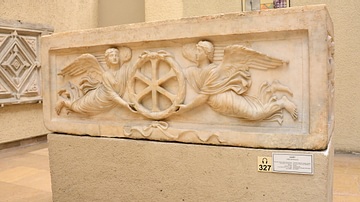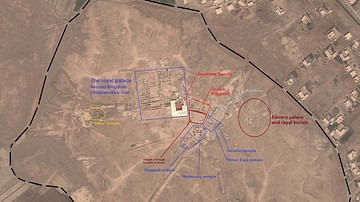Illustration
Much of the known pottery from the Euphrates region comes from tombs, often in large cemeteries attached to settlement sites. The tombs are of a variety of types, but most typically they consist of rock-cut or stone-built subterranean chambers designed for multiple successive use.
One of the largest excavated tombs of this sort is the so-called" hypogeum" at Til Barsip, which contained over 1000 complete pottery vessels. The pottery here is from various tombs in the Amarneh cemetery, arranged to give an impression of the density of material within such tombs. Early Bronze Age, 2600-2000 BCE. From Amarneh cemetery at Til Barsip, modern-day Aleppo Governorate, Syria. (The British Museum, London)
About the Author
Cite This Work
APA Style
Amin, O. S. M. (2017, September 08). Pottery from the Amarneh Cemetery at Til Barsip. World History Encyclopedia. Retrieved from https://www.worldhistory.org/image/7217/pottery-from-the-amarneh-cemetery-at-til-barsip/
Chicago Style
Amin, Osama Shukir Muhammed. "Pottery from the Amarneh Cemetery at Til Barsip." World History Encyclopedia. Last modified September 08, 2017. https://www.worldhistory.org/image/7217/pottery-from-the-amarneh-cemetery-at-til-barsip/.
MLA Style
Amin, Osama Shukir Muhammed. "Pottery from the Amarneh Cemetery at Til Barsip." World History Encyclopedia. World History Encyclopedia, 08 Sep 2017, https://www.worldhistory.org/image/7217/pottery-from-the-amarneh-cemetery-at-til-barsip/. Web. 17 Apr 2025.








